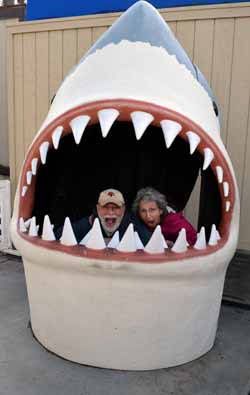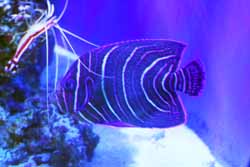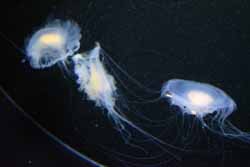
By Donald H. Harrison

LA JOLLA, California – If you want to know if a fish you see at the Birch Aquarium is kosher, look carefully. Does it have fins? Does it have scales? If the answer to both these questions is “yes,” then probably it is a kosher fish.
That doesn’t mean, however, that you should eat one like it, should you happen to pull one out of the sea. It could be dangerous to your health.
One of the current exhibits at the Birch Aquarium deals with fish and sea creatures that are “oddities.” Among them are two fish that indeed have fins and scales, but their descriptions ought to warn you away.
“Fugu Pufferfish (Takifugu alboplumbeus) — I may look appetizing but don’t try to eat me! Beyond being able to inflate my stomach to massive proportions, my tissues house bacteria that generate a toxin called Tetrodotoxin that is 1200x more lethal than cyanide.”
“Stonefish (Synanceia verrucosa) – My coloration, shape and stoic presence make me look like an an algae covered rock, but don’t let me fool you! The 13 hypodermic venom-delivering spines on my back make me the most venomous fish in the sea.”

Speaking of non-kosher fish, people at Birch Aquarium can take silly photos of themselves pretending to be inside the mouth of a great white shark, which has no scales. There also is an installation about leopard sharks (Triakis semifasciata), in which we learn that they can grow to a length of six feet, and that “hundreds of leopard sharks appear at La Jolla Shores every summer, where they play an important role in the local ecology and support ecotourism.”
The reason they like La Jolla is neither the proximity of UC San Diego, or its Scripps Institute of Oceanography (of which the Birch Aquarium is a part), nor the trendy stores of La Jolla Village. The real reason is that “leopard sharks typically stay on or near the bottom and favor warm shallow water near shore. At La Jolla Shores, they spend much of their day in water 6.5 feet deep or less.”
Lest this concern you about visiting the La Jolla Shores, the Birch Aquarium’s storyboard adds that leopard sharks “will flee from disturbances and are harmless to humans if not provoked.”
Luckily, other fish in the permanent collection are not only edible but also are beautiful or fascinating (or both) to look at. I was particularly taken with such species in the collection as the Flag rockfish, Garibaldi, California Halibut, Blue throated Fairy-wrasse, Koran Angelfish, Diamond Fish, Azure damselfish, Powderblue tang, Yellow Tang, Palette Surgeonfish, King Angelfish, and the Broomtail grouper.

I did a double take when I read about the the “Koran Angelfish,” wondering if there were also a “Torah Angelfish,” and a “Christian Bible Angelfish.” Subsequently, I found on the Saltwater Aquarist website this explanation: “The white stripes on its body become stretched, curved and elongated resembling something similar to Arabic script, thus leading to its name ‘Koran’. They are also commonly referred to as ‘Half-circle Angelfish’ and ‘Semicircle Angelfish.’”
A current exhibit deals extensively with seahorses, which are fish that adapted their shape to feed off vertically-growing vegetation. Turns out that in mating the female seahorse passes her eggs to a pouch of the male’s body, where the roe grow to become baby seahorses, and then, in a process similar to labor, the male seahorse expels them from his pouch. I’m willing to bet that there are many women out there who wish that human reproduction was a similar process!
Two species of sea life that I found rather fascinating were the Atlantic Flashlightfish (Kryptophanaron alfredi) and the Fried Egg Jelly (Phacellophora camtschatica).
A storyboard, written as if the flashlightfish was talking to us, said: “Under my eyes, I have specialized light organs (like headlights) that help me find prey at night. I can also use them to distract predators and communicate with members of my species.”
Wouldn’t such a feature be handy for humans, especially if they ran out of batteries?

The Fried Egg Jellyfish has a central mass “which resembles the cooked yolk of an egg in appearance.” This mass contains the jellyfish’s reproductive organs. This particular species of jellyfish, according to the aquarium’s printed explanation, “spends much of its time motionless. When searching for food, it pulses slowly through the water with its string tentacles trolling 10-20 feet below. Capable of growing up to 2 feet in diameter, the bell is frequently inhabited by symbiotic amphipods and juvenile crabs.”
I wondered if any sea creature occasionally jostled the Fried Egg Jellyfish, gently flipping it over so that it became the “Over Easy Jellyfish”? Oh well, probably not.
Following the tour of the aquarium, in which I was joined by cousins Harry and Sherry Jacobson-Beyer of Louisville, Kentucky, I stopped by the Splash! Café, which is on the grounds. I wondered what tasty denizens of the sea would be on the menu, and whether any of them would be kosher.
To my surprise, neither fish nor crustaceans were offered on the menu. Instead there were land-based foods including various vegetarian options and turkey hot dogs, bratwurst, ham sandwiches, chicken panini, roast beef panini, and steak caesar wrap.
I asked one of the countermen why there were no fish on the menu. He said it might be an affront to the fish swimming so happily nearby in their tanks.
Who knew fish might consider us humans to be chutzpahdik?
*
Harrison is editor of San Diego Jewish World. He may be contacted via donald.harrison@sdjewishworld.com Information about the Birch Aquarium, including directions and ticket prices, may be accessed via https://aquarium.ucsd.edu/
This was a fun and entertaining read! Thank you, Donald!